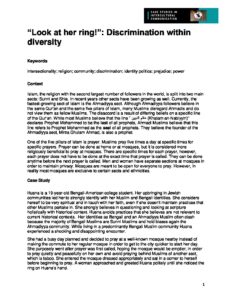“Look at her ring!”: Discrimination within diversity
Keywords
intersectionality; religion; community; discrimination; identity politics; prejudice; power
Context
Islam, the religion with the second largest number of followers in the world, is split into two main sects; Sunni and Shia. In recent years other sects have been growing as well. Currently, the fastest-growing sect of Islam is the Ahmadiyya sect. Although Ahmadiyya followers believe in the same Qur’an and the same five pillars of Islam, many Muslims disregard Ahmadis and do not view them as fellow Muslims. The disaccord is a result of differing beliefs on a specific line of the Qur’an. While most Muslims believe that the line “ خاتم النبيين (Khatam an-Nabiyyin)” declares Prophet Mohammed to be the last of all prophets, Ahmadi Muslims believe that this line refers to Prophet Mohammed as the seal of all prophets. They believe the founder of the Ahmadiyya sect, Mirza Ghulam Ahmad, is also a prophet.
One of the five pillars of Islam is prayer. Muslims pray five times a day at specific times for specific prayers. Prayer can be done at home or at mosques, but it is considered more religiously beneficial to pray at mosques. There are specific times for each prayer, however, each prayer does not have to be done at the exact time that prayer is called. They can be done anytime before the next prayer is called. Men and women have separate sections at mosques in order to maintain privacy. Mosques are meant to be open for everyone to pray. However, in reality most mosques are exclusive to certain sects and ethnicities.
Case Study
Husna is a 19-year-old Bengali-American college student. Her upbringing in Jewish communities led her to strongly identify with her Muslim and Bengali identities. She considers herself to be very spiritual and in touch with her faith, even if she doesn’t maintain practices that other Muslims partake in. She strongly believes in questioning and looking at scripture holistically with historical context. Husna avoids practices that she believes are not relevant to current historical contexts. Her identities as Bengali and an Ahmadiyya Muslim often clash because the majority of Bengali Muslims are Sunni Muslims and hold biases again the Ahmadiyya community. While living in a predominantly Bengali Muslim community Husna experienced a shocking and disappointing encounter.
She had a busy day planned and decided to pray at a well-known mosque nearby instead of making the commute to her regular mosque in order to get to the city quicker to start her day. She purposely went after prayer was first called, hoping the mosque would be emptier, in order to pray quietly and peacefully on her own and avoid praying behind Muslims of another sect, which is taboo. She entered the mosque dressed appropriately and sat in a corner to herself before beginning to pray. A woman approached and greeted Husna politely until she noticed the ring on Husna’s hand.
Many Ahmaddiya Muslims wear a ring that says, “is God not sufficient for his servant” (The Qur’an 39:36). For Ahmadiyya Muslims, the ring serves as a reminder of their faith. However, Sunni Muslims recognize the ring as a symbol of the Ahmadiyya sect and reject it.
With a sense of urgency, the woman suddenly started telling Husna that she should leave immediately, and she shouldn’t be at this mosque. Husna, confused and upset, continuously asked the woman “Why shouldn’t I be here? Why can’t I pray here?” Yet the woman frantically urged Husna to leave, telling her in both English and Bengali that she doesn’t belong there. Other women began approaching the two. The first woman began pointing at Husna’s ring and explaining to the other women that Husna should leave. As Husna tried to ignore the women and pray, the older women began using anti-Ahmadiyya slurs and continuously ushered Husna towards the exit. Husna tried to stay calm and explain to these women that they were not allowed to dictate who gets to pray in the mosque and who doesn’t. She even cited that Prophet Mohammed would allow non-Muslims to say their prayers in mosques. While holding back tears, Husna reprimanded the silent young women who were neither yelling at her to leave nor supporting her right to pray in that mosque. Many of them did not even understand the significance of the ring or the Ahmadiyya sect, yet they refused to support Husna in her efforts to communicate with the older women. Ultimately Husna forcefully walked out of the mosque while calmly wishing the women salaam. She took a bus to her usual mosque and upon entering, she broke down into tears, feeling heartbroken yet even more strongly committed to her faith as an Ahmadiyya Muslim.
Discussion Questions
- How is the intersectionality of religion, culture, and politics an important part of this case?
- How do our perceived identity differences influence the ways in which we represent ourselves and interact with others? How does this play out in Husna’s story?
- Why do you think the young women in the mosque remained silent?
- How do power dynamics come into play in this scenario to challenge or foster discrimination?
- Given the history and context of anti-Islamic sentiment in the United States, how might that impact an understanding of the cultural exchange between the women?
Additional Resources
- Chaudhary, Ayilah. “Surviving as an Ahmadi in Pakistan.” Pulitzer Center, 7 April 2020.
- Evans, Nicholas H. A. “Beyond Cultural Intimacy: The Tensions that Make Truth for India’s Ahmadi Muslims.” American Ethnologist, Vol. 44 No. 3, 14 August 2017.
- “Pakistan: Ensure Ahmadi Voting Rights.” Human Rights Watch, 28 June 2018.
- Petersen, Kristian. “Intersectional Islamophobia: The Case of a Black Ahmadi Muslim Celebrity.” Journal of Africana Religions, vol. 7 no. 1, 2019, p. 139-151. Project MUSE.
- “The Globe and Mail interviews the leader of the world’s Ahmadiyya Muslim community.” Youtube, uploaded by The Globe and Mail, 3 November 2016.
Corresponding Author
Akhter, Shajneen, American University, Washington, DC. Email: sa7980a@student.american.edu


